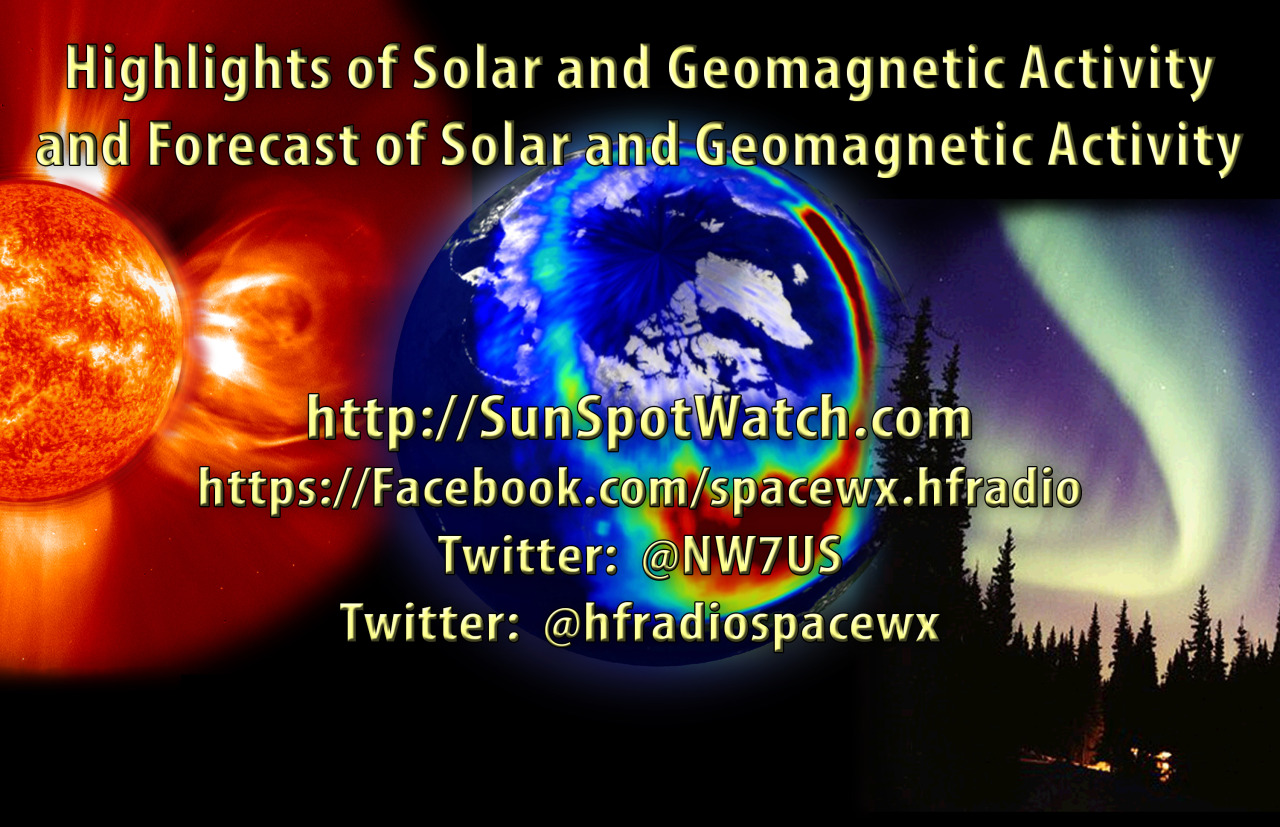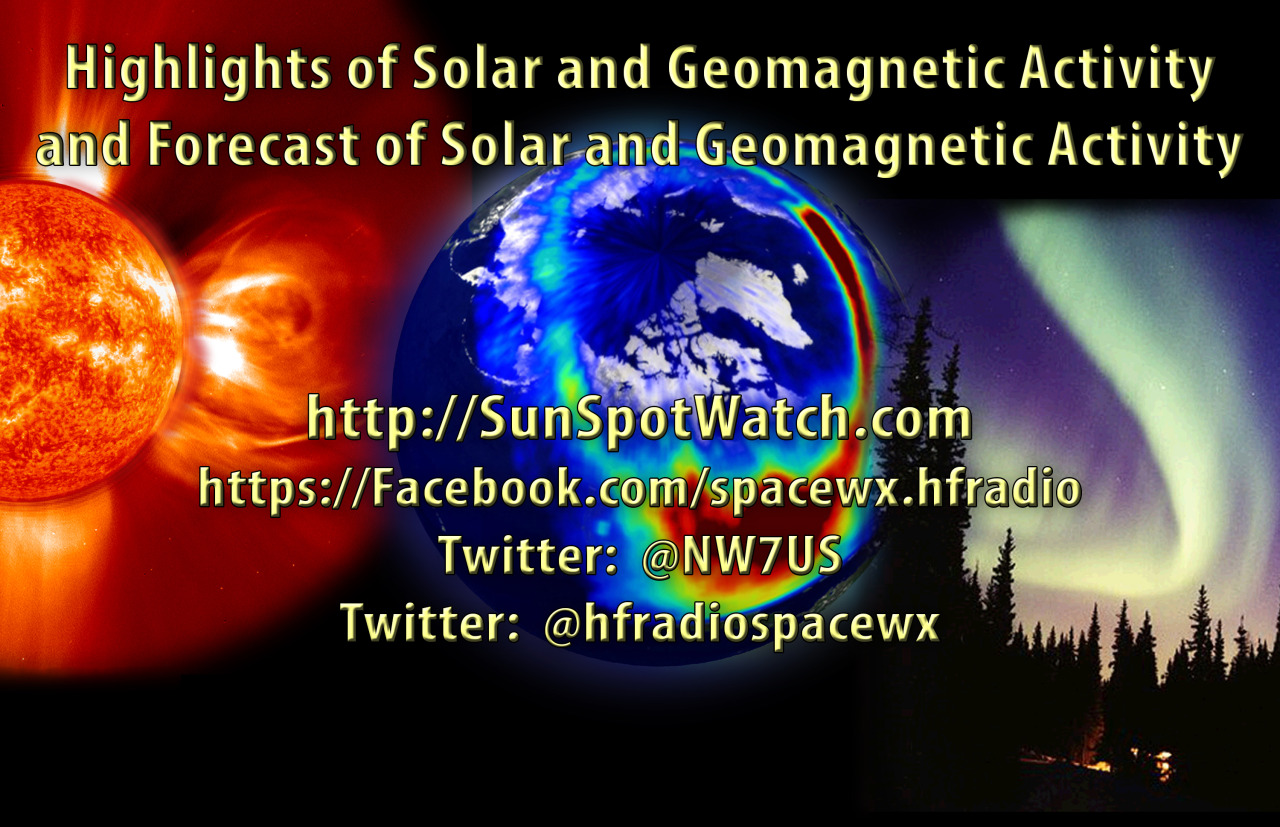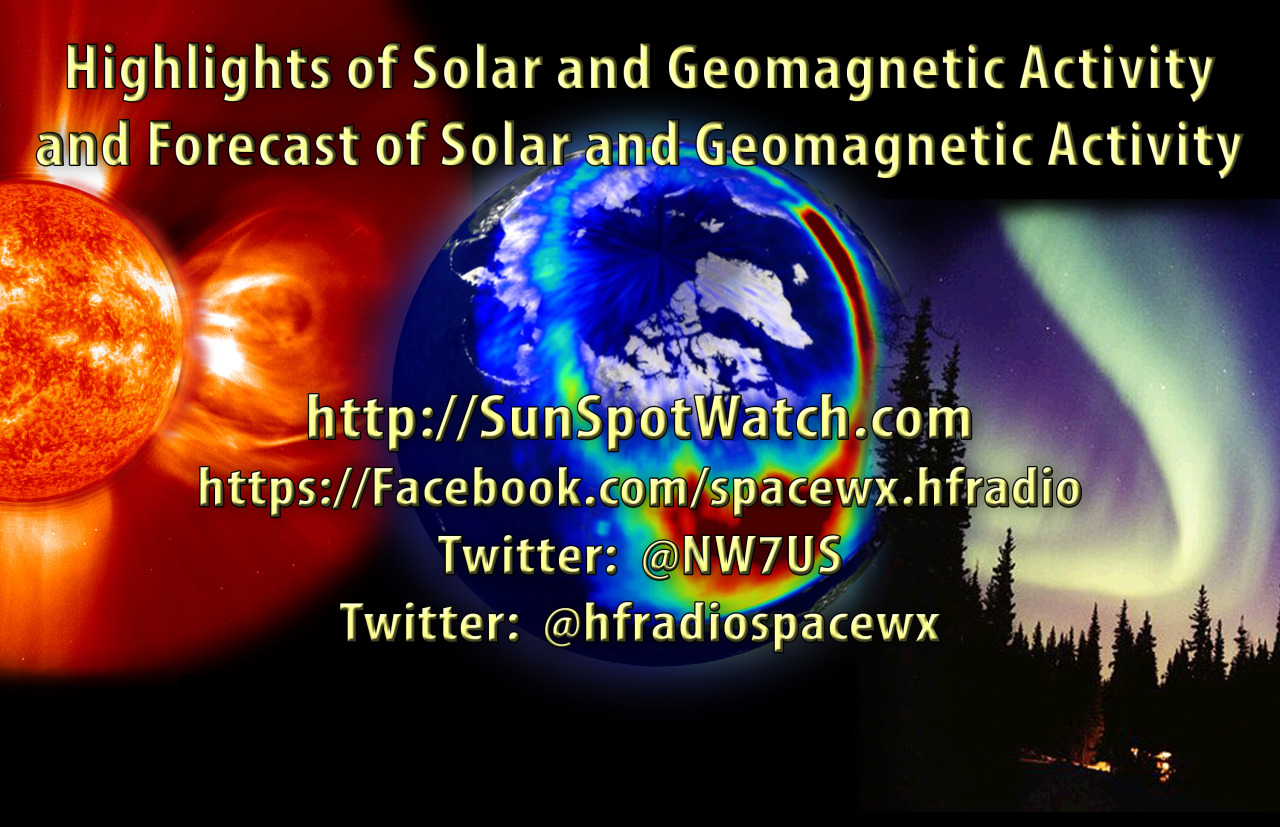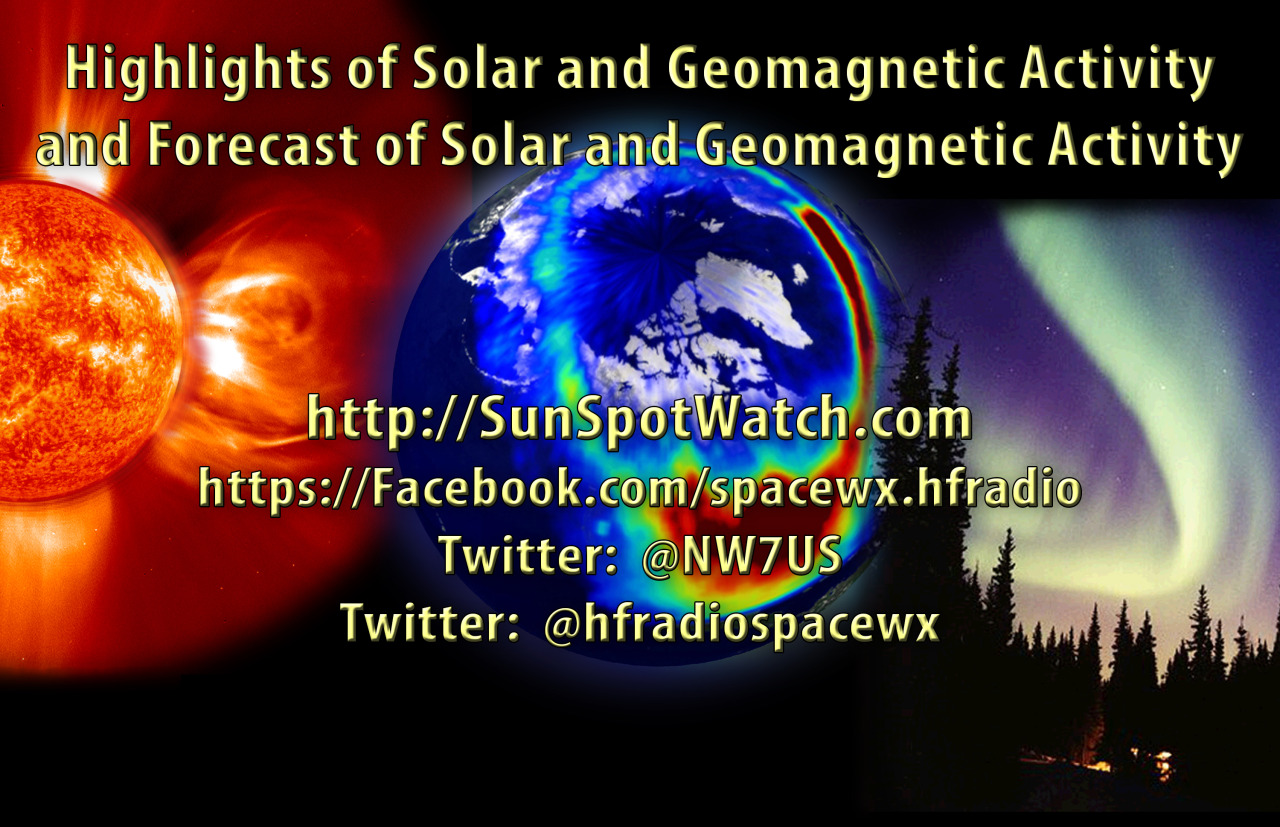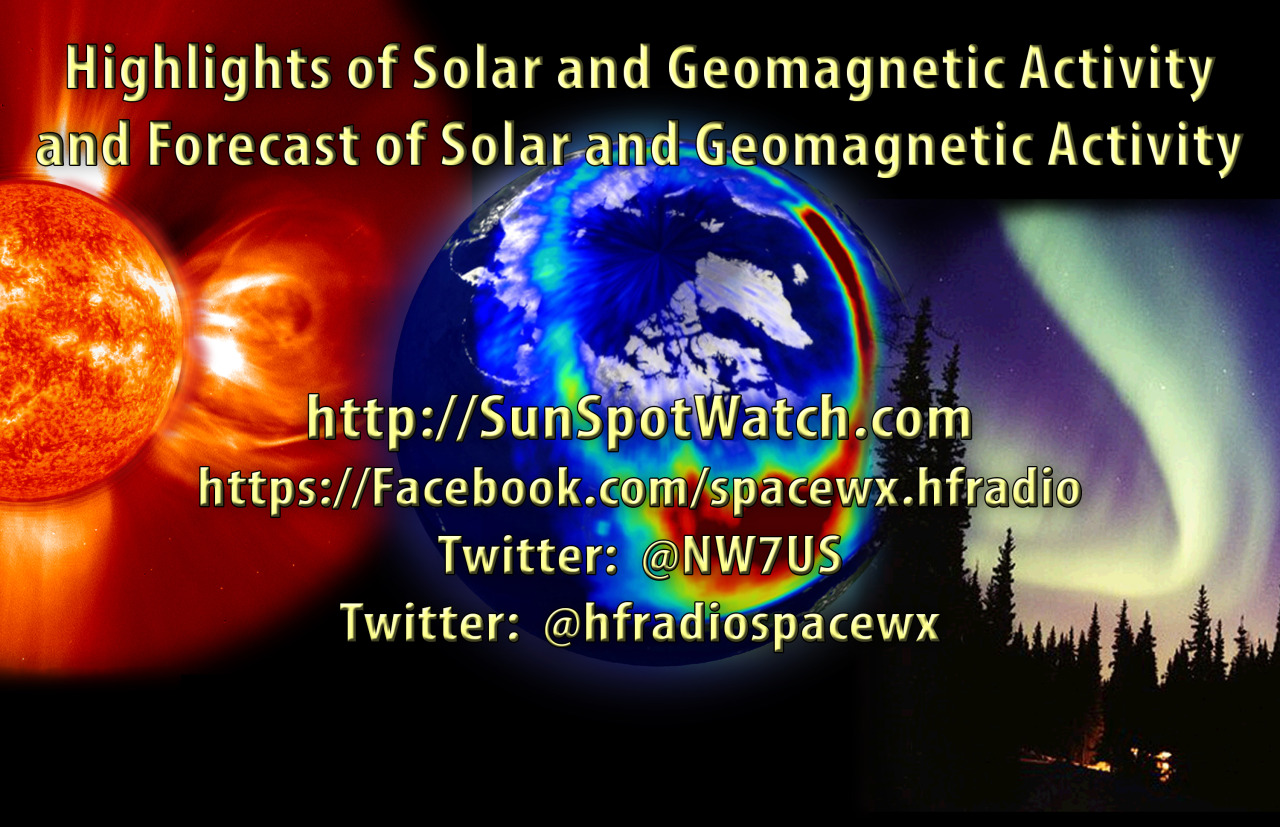Author Archive
 Weekly Propagation Summary – 2016 Feb 01 16:10 UTC
Weekly Propagation Summary – 2016 Feb 01 16:10 UTC
Here is this week’s space weather and geophysical report, issued 2016 Feb 01 0641 UTC.
Highlights of Solar and Geomagnetic Activity 25 – 31 January 2016
Solar activity was at very low to low levels during the period. Low levels were observed from 25-29 January with Regions 2488 (N02, L=320, class/area Dai/240 on 25 January) and 2489 (N10, L=253, class/area Eko/300 on 29 January) producing the majority of the C-class flaring. The largest flare of the period was a C9/1f at 28/1202 UTC from Region 2488. Region 2488 was in slow decay over the period. Region 2489 continued to exhibit growth through 28 January and slowly decayed thereafter. Several filament eruptions, and subsequent coronal mass ejections (CMEs), were observed during the period, but none had an Earth-directed component.
No proton events were observed at geosynchronous orbit.
The greater than 2 MeV electron flux at geosynchronous orbit was at high levels from 25-27 January, moderate levels on 28 January, and normal levels from 29-31 January. The maximum flux of the period was 2,117 pfu observed at 26/1500 UTC.
Geomagnetic field activity was at mostly quiet levels throughout the period with isolated unsettled periods on 27-28 and 31 January and an isolated active period observed late on 31 January. Solar wind parameters were in decline as the period began under the waning influence of a negative polarity coronal hole high speed stream (CH HSS). Solar wind speed gradually decreased from approximately 480 km/s early in the period to around 260 km/s by 30 January before increasing slightly to 300 km/s by the end-of-the-period. A solar sector boundary crossing into a positive (away) orientation occurred at approximately 27/0834 UTC, accompanied by a slight increase in total field (Bt) measurements to 9 nT on 27 and 28 January. On 31 January, another increase in Bt to 10 nT was observed along with a prolonged period of southward Bz. The geomagnetic field responded with isolated active levels to end the period.
Forecast of Solar and Geomagnetic Activity 01 February – 27 February 2016
Solar activity is expected to be at very low to low levels with a chance for M-class flares (R1-R2, Minor-Moderate) from 03-25 February with the return of old Regions 2484 (N08, L=094) and 2488 (N02, L=320).
No proton events are expected at geosynchronous orbit.
The greater than 2 MeV electron flux at geosynchronous orbit is expected to be at normal to moderate levels with high levels likely on 04-07, 09-15, and 18-23 February as a result of CH HSS influence.
Geomagnetic field activity is expected to be at unsettled to active levels on 01 February due to continued effects from a prolonged period of southward Bz. Unsettled to active levels are likely from 02-04, 08-09, and 17-20 February due to recurrent CH HSS activity.
Don’t forget to visit our live space weather and radio propagation web site, at: http://SunSpotWatch.com/
Live Aurora mapping is at http://aurora.sunspotwatch.com/
If you are on Twitter, please follow these two users: + https://Twitter.com/NW7US + https://Twitter.com/hfradiospacewx
Get the space weather and radio propagation self-study course, today. Visit http://nw7us.us/swc for the latest sale and for more information!
Check out the stunning view of our Sun in action, as seen during the last five years with the Solar Dynamics Observatory (SDO): https://www.youtube.com/watch?v=zXN-MdoGM9g
We’re on Facebook: http://NW7US.us/swhfr
 Weekly Propagation Summary – 2016 Jan 25 16:10 UTC
Weekly Propagation Summary – 2016 Jan 25 16:10 UTC
Here is this week’s space weather and geophysical report, issued 2016 Jan 25 0701 UTC.
Highlights of Solar and Geomagnetic Activity 18 – 24 January 2016
Solar activity was at very low to low levels during the period. Only weak C-class flares (<C3) were observed on 20-21 January and 24 January from Regions 2484 (N08, L=094, class/area Dro/030 on 20 January), 2487 (S13, L=336, class/area Dai/100 on 21 January), and 2488 (N04, L=319, class/area Dai/200 on 24 January). Region 2487 was in a growth phase since its emergence on 18 January, but entered into a decay phase after 22 January and was only responsible for three weak C-class flares. Region 2488 continued to exhibit growth since its emergence on the disk on 18 January and was responsible for two weak C-class flares. No Earth-directed coronal mass ejections (CMEs) were observed during the summary period.
No proton events were observed at geosynchronous orbit.
The greater than 2 MeV electron flux at geosynchronous orbit was at normal levels on 19-20 January, moderate levels on 21 January and high levels on 18 January and again on 22-24 January. The maximum flux of the period was 12,881 pfu observed at 24/1550 UTC.
Geomagnetic field activity ranged from quiet to major storm (G2-Moderate) levels. The period began under quiet conditions for the majority of 18 January. At approximately 18/2056 UTC, a small shock was observed in ACE data indicating the arrival of a CME from a filament eruption on 14 January. Total field (Bt) initially increased from 6 nT to 12 nT with solar wind speed increasing from 300 km/s to near 380 km/s while the Bz component fluctuated between +6 nT and -9 nT. By 19/0935 UTC, the Bz component deflected north and total field increased to 14 nT. A subsequent rotation of the Bz component occurred after 20/0325 UTC to a maximum of -13 nT followed by another increase in the total field to a maximum of 21 nT at 21/0545 UTC. By this time, the Bz component was fluctuating between +/-18 nT. By 21/1006 UTC, Bt decreased to around 8 nT, while the solar wind speed increased to around 530 km/s as the solar wind began to transition into a negative polarity coronal hole high speed stream (CH HSS). The geomagnetic field responded with an unsettled period late on 18 January, quiet to active levels on 19 January, quiet to minor storm levels (G1-Minor) on 20 January, and unsettled to major storm levels (G2-Moderate) on 21 January. Solar wind speeds continued around 500-550 km/s under CH HSS influence until late on 23 January. Solar wind speeds continued to be elevated in the 450-500 km/s range through the end of the period. As a result, the geomagnetic field was at quiet to active periods from 22-24 January.
Forecast of Solar and Geomagnetic Activity 25 January – 20 February 2016
Solar activity is expected to be at very low to low levels with a slight chance for an M-class flare (R1-R2, Minor-Moderate) from 25-31 January as Region 2488 continues to develop.
No proton events are expected at geosynchronous orbit.
The greater than 2 MeV electron flux at geosynchronous orbit is expected to be at mostly high levels due to recurrent CH HSS activity. A return to moderate levels is expected on 25-26 January, 07-08 February, and 14-18 February.
Geomagnetic field activity is expected to be at unsettled to active levels from 25-30 January, 02-03 February, 07-10 February, and 17-20 February due to recurrent CH HSS activity.
Don’t forget to visit our live space weather and radio propagation web site, at: http://SunSpotWatch.com/
Live Aurora mapping is at http://aurora.sunspotwatch.com/
If you are on Twitter, please follow these two users: + https://Twitter.com/NW7US + https://Twitter.com/hfradiospacewx
Get the space weather and radio propagation self-study course, today. Visit http://nw7us.us/swc for the latest sale and for more information!
Check out the stunning view of our Sun in action, as seen during the last five years with the Solar Dynamics Observatory (SDO): https://www.youtube.com/watch?v=zXN-MdoGM9g
We’re on Facebook: http://NW7US.us/swhfr
 Weekly Propagation Summary – 2016 Jan 18 16:10 UTC
Weekly Propagation Summary – 2016 Jan 18 16:10 UTC
Here is this week’s space weather and geophysical report, issued 2016 Jan 18 0131 UTC.
Highlights of Solar and Geomagnetic Activity 11 – 17 January 2016
Solar activity ranged from very low to low levels. Very low conditions were observed on 11-14 January and again on 16-17 January. Low levels occurred on 15 January with a few weak C-class flares observed from Region 2480 (N02, L=125, class/area Eso/190 on 10 Jan). A 14 degree long filament, centered near S30W03, erupted between 14/1803-2048 UTC. An associated coronal mass ejection (CME) was visible in SOHO LASCO imagery beginning at 14/2324 UTC. Analysis, and subsequent WSA-Enlil model output, determined a potential glancing blow could impact Earth early on 19 Jan.
No proton events were observed at geosynchronous orbit.
The greater than 2 MeV electron flux at geosynchronous orbit was at high levels throughout the summary period.
Geomagnetic field activity began the period on 11-14 January at quiet to active levels due to effects from a negative polarity coronal hole high speed stream (CH HSS). Quiet conditions persisted on 15-17 January. ACE satellite parameters indicated a maximum wind speed reading of 662 km/s at 12/0711 UTC. By period's end, wind speeds had declined to about 330 km/s. Total field (Bt) reached a maximum reading of 10 nT late on the 10th and generally ranged between 3-7 nT for a majority of the period. The Bz component varied between +/- 7 nT from late on the 11th through early on the 13th. Through the remainder of the period, Bz did not vary much beyond +/- 4 nT. The phi angle was in a predominately negative (towards) orientation through midday on 16 January when a rotation to a more positive (away) sector was observed.
Forecast of Solar and Geomagnetic Activity 18 January – 13 February 2016
Solar activity is expected to be at very low levels with a chance for C-class flares throughout the outlook period.
No proton events are expected at geosynchronous orbit.
The greater than 2 MeV electron flux at geosynchronous orbit is expected to be at high levels on 18, 23-26, 29-31 January, 01-06 and 09-13 February. Normal to moderate levels are expected for the remainder of the outlook period.
Geomagnetic field activity is expected to be at unsettled to active periods on 18-19 January due to possible glancing blow effects from the 14 Jan CME. Unsettled to active levels are expected on 22-23, 28-29 January, 02-03 and 07-09 February due to recurrent CH HSS effects. Predominately quiet levels are expected for the remainder of the outlook period.
Don’t forget to visit our live space weather and radio propagation web site, at: http://SunSpotWatch.com/
Live Aurora mapping is at http://aurora.sunspotwatch.com/
If you are on Twitter, please follow these two users: + https://Twitter.com/NW7US + https://Twitter.com/hfradiospacewx
Get the space weather and radio propagation self-study course, today. Visit http://nw7us.us/swc for the latest sale and for more information!
Check out the stunning view of our Sun in action, as seen during the last five years with the Solar Dynamics Observatory (SDO): https://www.youtube.com/watch?v=zXN-MdoGM9g
We’re on Facebook: http://NW7US.us/swhfr
 I Need You in My Log! SKCC K3Y/0 Special Event (January 2016)
I Need You in My Log! SKCC K3Y/0 Special Event (January 2016)
I need your help!
Come meet me on the shortwave (HF) ham bands for the Morse code (CW mode) special event, the Straight Key Century Club (SKCC) celebration, with special callsign, K3Y. During the shifts (time slots) listed below, I am the control operator as K3Y/0.
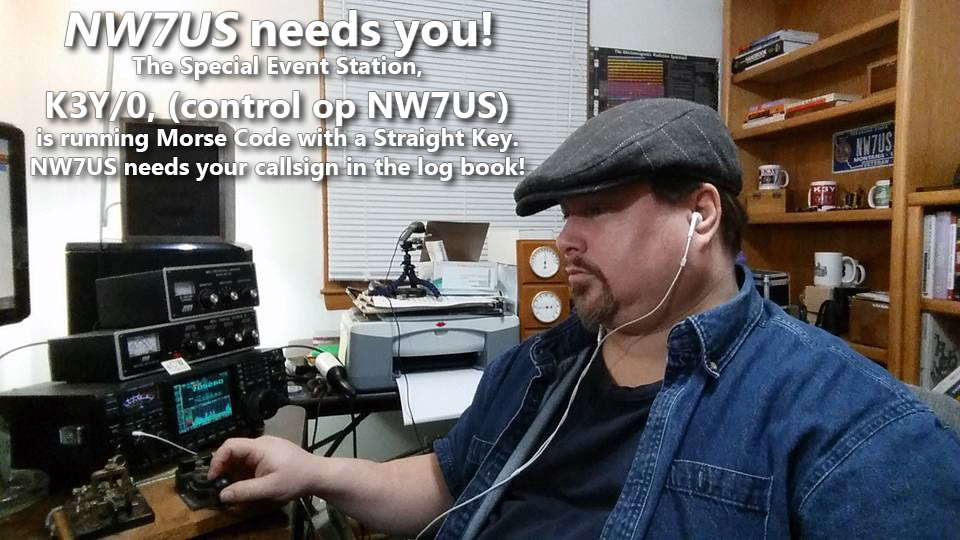 I need you to make a contact with me.
I need you to make a contact with me.
This special event takes place every year during January. We celebrate the legacy of Morse code, and promote Morse code and manual creation of the code by any non-electronic (digital) device and method. Which means that we love mechanical bugs, straight keys, two ends of a wire, or any other manual device, if Morse code is generated. The Straight Key Century Club is a free membership group. The link to their website is below.
I need you to make a contact with me, during my scheduled times, listed below.
NOTE: YOU DO NOT NEED TO BE A MEMBER OF THE (free) SKCC GROUP. To get into my logbook, you meet me on my frequency, and use Morse code to communicate with me. It is painless. If you must, you can use computer-generated Morse code. Or, you can tap it out on any Morse code signalling device, like a bug, a set of paddles, or a straight key; whatever you choose to make Morse code emanate from your HF transmitter.
HOWEVER: For those of you who want to get fully immersed in the spirit of this event, you are invited to use a straight key. And, as a bonus, you may and can join the SKCC group for FREE. Then, you would have your own SKCC number. That’d be cool; we SKCC members use that number in our exchange during our QSO information exchange. But, you don’t need that. Since it is free, why not?
What is needed is simply you, getting on the shortwave band, finding me, hearing me, and responding to me with Morse code. In other words, we need to have a QSO using Morse code. I am not a fast operator, so no problem if you are not very fast. I’ll meet your speed.
In any case, here are some of the times I will be on the air as K3Y/0… please dust off your straight key, bug, paddles, whatever, and make a QSO with me. Thanks!
My current schedule:
UTC Start/End (remember, these are NOT your local times, but are the UTC (GMT) times!)
(revised times, as of edit date)
00:00 - 02:59 19-Jan-16
00:00 - 02:59 20-Jan-16
00:00 - 02:59 21-Jan-16
00:00 - 02:59 22-Jan-16
00:00 - 05:59 23-Jan-16
14:00 - 18:59 23-Jan-16
20:00 - 21:59 23-Jan-16
00:00 - 02:59 24-Jan-16
14:00 - 18:59 24-Jan-16
21:00 - 21:59 24-Jan-16
00:00 - 02:59 25-Jan-16
00:00 - 02:59 26-Jan-16
00:00 - 02:59 27-Jan-16
00:00 - 02:59 28-Jan-16
00:00 - 02:59 29-Jan-16
00:00 - 05:59 30-Jan-16
13:00 - 18:59 30-Jan-16
20:00 - 21:59 30-Jan-16
00:00 - 03:59 31-Jan-16
13:00 - 23:59 31-Jan-16
Now, what frequency will I be on?
To find out what frequency I am on:
Visit http://g.nw7us.us/sched4SKCC and look on the right side for my callsign, NW7US. I usually post my frequency of operation right after my call sign.
Typically, evening operation is 30m, then 40m, and then possibly 80m.
If you are trying to alert me to your presence, you may message me on my personal Facebook profile, under my “Tomas David Hood” profile messages, but I may not see that right away.
Here is the detail covering the K3Y operation and the SKCC group: http://skccgroup.com/k3y
73 de NW7US
dit dit
This was last year:
https://www.youtube.com/watch?v=UfRvITFpTb4
..
 Weekly Propagation Summary – 2016 Jan 11 16:10 UTC
Weekly Propagation Summary – 2016 Jan 11 16:10 UTC
Here is this week’s space weather and geophysical report, issued 2016 Jan 11 0123 UTC.
Highlights of Solar and Geomagnetic Activity 04 – 10 January 2016
Solar activity was at very low to low levels. Very low activity was observed on 04-05 January and 08-10 January while isolated low activity occured on 06-07 January. A pair of C1 x-ray events were observed from Region 2480 (N02, L=125, class/area Eso/190 on 10 Jan) on 06/1137 UTC and 07/0617 UTC, respectively. No Earth-directed coronal mass ejections were observed during the summary period.
No proton events were observed at geosynchronous orbit.
The greater than 2 MeV electron flux at geosynchronous orbit was at high levels throughout the period.
Geomagnetic field activity was at predominately quiet levels on 04-05 January and 08-10 January. On 06 January, activity increased to unsettled to active levels with an isolated period of minor storming (G1-Minor) observed early on the 6th. Unsettled to active conditions persisted through late on the 7th. This increase in activity was due to the presence of a recurrent, positive polarity coronal hole high speed stream (CH HSS). Solar wind parameters, measured at the ACE satellite, indicated an increase in wind speeds early on 06 Jan from about 475 km/s to a peak of 643 km/s at 06/1025 UTC. Wind speeds remained elevated between 575 – 625 km/s through about 07/2000 UTC when a gradual decline to about 430 km/s were observed through the end of the summary period. Total field (Bt) averaged about 5 nT for a majority of the period, but ranged from 7-16 nT from 05/0820 UTC – 06/0131 UTC. The Bz component varied between +/- 4 nT with increased variability recorded between +12 nT to -10 nT from 05/0935 UTC to 06/0022 UTC. The phi angle was in a predominately positive (away for the Sun) orientation throughout the summary period.
Forecast of Solar and Geomagnetic Activity 11 January – 06 February 2016
Solar activity is expected to be at very low to low levels from 11-14 January and from 29 January – 06 February. From 15-28 January, activity levels are expected to increase to low to moderate levels (R1-Minor) due to the return of old active Region 2473 (S21, L=334).
No proton events are expected at geosynchronous orbit.
The greater than 2 MeV electron flux at geosynchronous orbit is expected to be at normal to moderate levels on 11-12, 17-22, 26-28 January and 31 January – 02 February. High levels are expected on 13-16, 23-25, 29-30 January and 03-06 February due to enhanced winds from a series of geoeffective CH HSSs.
Geomagnetic field activity is expected to be at unsettled to active conditions on 12-13, 22-23, 28-29 January and 02-03 February with isolated minor storm levels (G1-Minor) likely on 12 and 18 January, all due to a series of recurrent CH HSSs. Quiet to unsettled conditions are expected for the remaining days of the outlook period.
Don’t forget to visit our live space weather and radio propagation web site, at: http://SunSpotWatch.com/
Live Aurora mapping is at http://aurora.sunspotwatch.com/
If you are on Twitter, please follow these two users: + https://Twitter.com/NW7US + https://Twitter.com/hfradiospacewx
Get the space weather and radio propagation self-study course, today. Visit http://nw7us.us/swc for the latest sale and for more information!
Check out the stunning view of our Sun in action, as seen during the last five years with the Solar Dynamics Observatory (SDO): https://www.youtube.com/watch?v=zXN-MdoGM9g
We’re on Facebook: http://NW7US.us/swhfr
 Weekly Propagation Summary – 2016 Jan 04 16:10 UTC
Weekly Propagation Summary – 2016 Jan 04 16:10 UTC
Here is this week’s space weather and geophysical report, issued 2016 Jan 04 0534 UTC.
Highlights of Solar and Geomagnetic Activity 28 December – 03 January 2016
Solar activity ranged from very low to moderate levels. Very low activity was observed on 03 Jan, low level activity on 29 Dec – 01 Jan, and moderate level activity on 28 Dec and 02 Jan. Region 2473 (S22, L=331, class/area=Fkc/590 on 26 Dec), which exhibited a complex beta-gamma-delta configuration, produced all of the significant flare activity (2 M-class, 14 C-class).
On 28 Dec, Region 2473 produced an M1 flare at 28/1245 UTC. Associated with this event was a Type IV radio emission and a partial-halo CME observed off the southern portion of the disk, first visible in LASCO coronagraph imagery at 12/1212 UTC. Analysis of this CME determined that an Earth-directed component was present.
On 02 Jan, Region 2473 produced a long duration M2 flare at 02/0011 UTC. Associated with this event were Type II (1095 km/s) and IV radio emissions and an assymetric partial-halo CME observed off the southwest limb, first visible in LASCO coronagraph imagery at 01/2324 UTC. Analysis of this CME determined that a weak Earth-directed component was present and would arrive around midday on 03 Jan, though eventually proved to be a miss.
There was greater than 10 MeV proton event on 02 Januaury 2016. The event began at 02/0430 UTC shortly after a long duration M2 flare that accured at 02/0011 UTC. Proton flux reached a maximum flux value of 21 pfu (S1-Minor) at 02/0450 UTC and ended at 02/0750 UTC.
The greater than 2 MeV electron flux at geosynchronous orbit was at high levels throughout the period with the exception of 31 December when moderate flux levels were observed. A maximum flux of 6,782 pfu was observed at 03/1600 UTC.
Geomagnetic field activity ranged from quiet to moderate (G2) storm conditions. At 31/0003 a small shock was observed at the ACE spacecraft. Total field (Bt) increased from 5 nT to 13 nT with a corresponding solar wind speed increase from 350 km/s to 500 km/s. The shock was associated with the arrival of the 28 Dec CME observed in LASCO C2 imagery at 28/1212 UTC. Isolated G1-Minor to G2-Moderate storm conditions were observed midday through late on 31 Dec as well as early on 01 Jan. Mostly quiet conditions were observed on 28 – 30 Dec, 02-03 Jan.
Forecast of Solar and Geomagnetic Activity 04 January – 30 January 2016
Solar activity is expected to be at low levels with a chance for M-class (R1-R2, Minor-Moderate) flare activity from 15 Jan – 28 Jan due to the return of Region 2473 (S22, L=331). Very low solar activity is expected for the remainder of the period.
No proton events are expected at geosynchronous orbit.
The greater than 2 MeV electron flux at geosynchronous orbit is expected to be high from 04 – 13 Jan, 25 – 30 Jan due to recurrent coronal hole high speed streams (CH HSS).
Geomagnetic field activity is expected to be at active levels on 04, 07, and 22 Jan with G1-Minor storm conditions on 06 Jan due to recurrent CH HSS activity. Mostly quiet to unsettled levels are expected for the rest of the period.
Don’t forget to visit our live space weather and radio propagation web site, at: http://SunSpotWatch.com/
Live Aurora mapping is at http://aurora.sunspotwatch.com/
If you are on Twitter, please follow these two users: + https://Twitter.com/NW7US + https://Twitter.com/hfradiospacewx
Get the space weather and radio propagation self-study course, today. Visit http://nw7us.us/swc for the latest sale and for more information!
Check out the stunning view of our Sun in action, as seen during the last five years with the Solar Dynamics Observatory (SDO): https://www.youtube.com/watch?v=zXN-MdoGM9g
We’re on Facebook: http://NW7US.us/swhfr
 Weekly Propagation Summary – 2015 Dec 28 16:10 UTC
Weekly Propagation Summary – 2015 Dec 28 16:10 UTC
Here is this week’s space weather and geophysical report, issued 2015 Dec 28 0317 UTC.
Highlights of Solar and Geomagnetic Activity 21 – 27 December 2015
Solar activity ranged from low to moderate levels (R1-Minor) with low activity observed on 25, 26, and 27 Dec, and moderate activity observed on 21, 22, 23, and 24 Dec. The majority of the flare activity occurred from Regions 2472 and 2473. Region 2472 (N04, L=331, class/area Dai/170 on 23 Dec) produced an M2/Sf at 21/0103 UTC and an M1/1n at 21/1014 UTC before decaying. Region 2473 (S22, L-331, class/area Fkc/590 on 26 Dec), the largest region on the disk, produced an M1/Sf at 22/0341 UTC, an M4/1f at 23/0040 UTC, and an M1 at 24/0212 UTC. Multiple eruptions were observed in coronagraph imagery, but all were directed off the east limb and none were geoeffective.
No proton events were observed at geosynchronous orbit.
The greater than 2 MeV electron flux at geosynchronous orbit was at normal to high levels through the entire week 21 December – 27 December.
Geomagnetic field activity reached G1 (Minor) to G2 (Moderate) storm levels early on 21 Dec due to effects from a CME that erupted on 16 Dec. G2 storm condtions were observed from 21/0000-0600 UTC, with G1 storm conditions occurring in the 21/0600-0900 UTC synoptic period. Solar wind parameters at the ACE spacecraft were enhanced with Bt reaching as high as 18 nT and prolonged periods of southward magnetic field (-Bz). An isolated period of active conditions was observed early on 22 Dec due to lingering CME effects. Active conditions occurred late on 23 Dec due to weak substorming. Quiet to unsettled conditions were observed on 24, 25, and 27 Dec. The geomagnetic field reached G1 (Minor) storm conditions late on 26 Dec (26/2100-2359 UTC) due to a negative polarity coronal hole high speed stream (CH HSS).
Forecast of Solar and Geomagnetic Activity 28 December – 23 January 2016
Solar activity is expected to be at low to moderate levels (R1-Minor) throughout the period. Moderate activity is likely through 03 Jan as Regions 2472 (N04, L=329) and 2473 (S22, L=332) rotate off the disk. Low activity levels are expected on 04-23 Jan with moderate activity possible on 15-23 Jan as Regions 2472 and 2473 rotate back onto the visible side of the disk.
No proton events are expected at geosynchronous orbit.
The greater than 2 MeV electron flux at geosynchronous orbit is expected to be at moderate to high levels on 28 Dec – 12 Jan in response to coronal hole high speed stream (CH HSS) effects. Normal to moderate levels are expected on 13-23 Jan.
Geomagnetic field activity is expected to be at active levels on 01, 03 Jan with G1 (Minor) storm conditions on 02 Jan due to a positive polarity CH HSS. G1 storm conditions are likely again on 06 Jan with active levels following on 07 Jan due to a positve polarity CH HSS. 10 and 11 Jan are likely to see G1 storm and active conditions, respectively due to a negative polarity CH HSS. Generally quiet to unsettled conditions are expected from 13-23 Jan.
Don’t forget to visit our live space weather and radio propagation web site, at: http://SunSpotWatch.com/
Live Aurora mapping is at http://aurora.sunspotwatch.com/
If you are on Twitter, please follow these two users: + https://Twitter.com/NW7US + https://Twitter.com/hfradiospacewx
Get the space weather and radio propagation self-study course, today. Visit http://nw7us.us/swc for the latest sale and for more information!
Check out the stunning view of our Sun in action, as seen during the last five years with the Solar Dynamics Observatory (SDO): https://www.youtube.com/watch?v=zXN-MdoGM9g
We’re on Facebook: http://NW7US.us/swhfr
